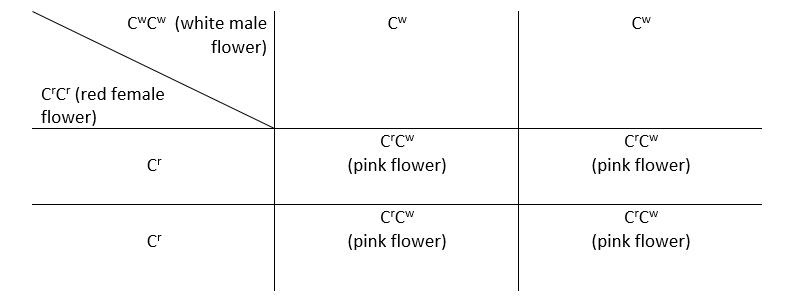Home » EasyHSC | Australia’s Best HSC Preparation Resources » EasyBio | HSC Biology Studies » Heredity » Genetic Variation » Model the formation of new combinations of genotypes
Model the formation of new combinations of genotypes
Model the formation of new combinations of genotypes produced during meiosis, including but not limited to:
- Interpreting examples of autosomal, sex-linkage, co-dominance, incomplete dominance and multiple alleles (ACSBL085)
- Constructing and interpreting information and data from pedigrees and Punnett squares
Autosomal Genotype:
- Combination of genes found in autosomes (chromosomes except for the sex chromosome)
- For genes on an autosome (any chromosome other than a sex chromosome), the alleles and their associated traits are autosomal dominant or autosomal recessive.
- Example: A cross was conducted between peas that may be round, associated with allele R, or wrinkled, associated with allele r. In this case, three combinations of alleles (genotypes) are possible: RR, Rr, and rr. The RR individuals have round peas and the rr individuals have wrinkled peas. In Rr individuals the R allele masks the presence of the r allele, so these individuals also have round peas. Thus, allele R is dominant to allele r, and allele r is recessive to allele R.
Sex-linkage:
- Phenotypic expression of the allele that depends on the sex chromosome.
- These genes are considered sex-linked because their expression and inheritance patterns differ between males and females.
- Example: A case study on Haemophilia:
- Haemophilia is an X linked disorder, meaning that the cause of haemophilia is a mutation in the genes of X chromosome. In females, the X chromosome remains in double copy (XX), so for haemophilia to occur, both the X chromosomes need to have a mutant gene. In males, presence of a single mutant X chromosome (since male sex chromosome has a combination XY) is enough to cause haemophilia.
- Analysis by Punnett square:
- Let,
XH = normal functioning X gene
Xh = haemophilic X gene
- Let,

From the above Punnett square, it can be seen that in a cross between a normal male and carrier female, only 25% of the F1 generation are found to haemophilic and are males.
Co-dominance:
- A type of gene interaction in which both the alleles are fully expressed resulting in a combined phenotype of both alleles.
- Example and representation using Punnett square:
- A cross was conducted between a black Andalusian rooster and a white Andalusian hen.
Let,
BB = genotype for black feathers in chicken
bb = genotype for white feathers in chicken
After the cross it was observed that all the offsprings having Bb genotype neither were black nor white rather were black with white spots.
- A cross was conducted between a black Andalusian rooster and a white Andalusian hen.

Incomplete Dominance:
- In this process of gene interaction, none of the alleles are dominant/fully expressed resulting in the creation of a different phenotype from the parents.
- Example and representation using Punnett square:
Let,
Cr = genotype for red flower (dominant)
Cw = genotype for white flower (dominant)
Both of the genes are dominant in their own locus. When they combine, the flowers having both the genes are neither red nor white rather, they exhibit a pink colour.- Punnett Square representation:

In a cross between a red and a white flower, the resultant F1 generation are all pink flower. Two members of the F1 generation are taken and crossed again to give F2 which will give the following results.

Multiple Alleles:
- Three or more alternative forms of an allele that can create a variant number of phenotypes when exist in different numbers.
- As an example, let’s consider a gene that specifies coat color in rabbits, called the C gene.
- The C gene comes in four common alleles: C, cch, ch, and c:
- A CC rabbit has black or brown fur
- A cchcch, rabbit has chinchilla coloration (grayish fur)
- A chch rabbit has Himalayan (color-point) patterning, with a white body and dark ears, face, feet, and tail
- A cc rabbit is albino, with a pure white coat.
Extract from HSC Biology Stage 6 Syllabus. © 2017 Board of Studies NSW.
